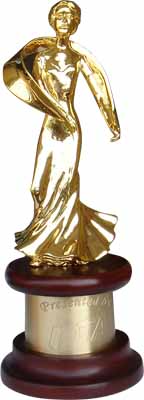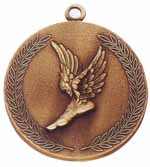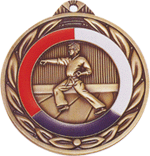Below
please find the main process types we use for making our items.
Die Struck / Stamping

For a
distinguished and elegant look, look no further than a Die
Struck pin without color fills. We start by creating a die with
your design in it and we use this die to strike your design in a
copper base metal. This process creates raised and recessed
areas. The recessed areas can be textured or sandblasted to give
your design depth and distinction. Finally, the raised areas are
polished to a mirror like finish and your pin is than plated in
Gold, Silver, Bronze, Nickel, or Black Nickel. Antique finishes
can be applied for a truly unique look.
Standard
Thickness: 1.2mm to 1.6mm depending on the size of your pin
Advantages: A jewelry quality pin; high perceived value; can be
less expensive than many enamel filled pins.
Disadvantages: None
Die Struck Soft
Enamel

This is a
very traditional and economical process. We start by creating a
die with your design in it and we use this die to strike your
design in an iron or copper base metal. This process creates
raised and recessed areas. The recessed areas are filled with
enamel paints in the colors of your choice. The enamel is filled
below the top level of the pin to protect the enamel while
maintaining the traditional look. Finally, the raised areas are
polished to a mirror like finish and your pin is then plated in
Gold, Silver, Bronze, Nickel, or Black Nickel. An optional epoxy
varnish can be added to further protect your pin.
Standard
Thickness: 1mm to 1.6mm depending on the base metal and size of
your pin
Advantages: Traditional look; low price for high quantities.
Disadvantages: Not good for highly detailed designs.
Cloisonne

For
unsurpassed quality and colors with unbelievable depth, there is
no other choice than Cloisonne. The ancient art of Cloisonnedeveloped in China thousands of years ago is still alive at
CustomMedals.biz We start by creating a die with your design in it and
we use this die to strike your design in a copper base metal. We
then apply ground colored glass to your pin and bake it at 1600
degrees until the glass liquefies and then hardens. Your pin is
then polished to a smooth finish to reveal your hand crafted
design. Finally your pin is plated in Gold, Silver, Bronze,
Nickel, or Black Nickel.
Standard
Thickness: 1.2mm to 1.6mm depending on the size of your pin
Advantages: A collectable jewelry quality pin; unsurpassed
durability; highest perceived value.
Disadvantages: None
Die Cast


This is the
most economical process for producing larger items including
medals, letter openers, coasters and statuettes. Metal alloy
(typically Zink alloy) is injected into a mold (die) under
high pressure of 10-210Mpa (1,450-30,500) psi . The
resulting surface finish, although with slightly less detail
than can be seen with die struck items, has a good dimensional
accuracy, as good as 0.2 % of casting dimension.
Standard
Thickness: there is no standard this material and process is
very flexible
Advantages: Excellent quality look; lowest price for high
quantities.
Disadvantages: softer and easier to destroy although it will
still take a hammer and a vice to do so!
Die Cast Enamel

This is very
similar to Cloisonne, but a lot cheaper. Metal alloy (typically
Zink alloy) is injected into a mold (die) under high pressure
of 10-210Mpa (1,450-30,500) psi. When the metal cools we are
left with a perfectly formed item. This process creates raised
and recessed areas. The recessed areas are filled with enamel in
the colors of your choice. The enamel is filled to the top level
of the pin maintaining the traditional Cloisonnelook. Finally,
all is polished to a mirror like finish and your pin is then
plated in Gold, Silver, Bronze, Nickel, Black Nickel, or a Black
Di finish. An optional epoxy varnish can be added to further
protect your pin.
Standard
Thickness: there is no standard this material and process is
very flexible
Advantages: Excellent quality high value look of Cloisonnebut
much lower prices.
Disadvantages: colors are not as deep or bright as Cloisonne
Chemical Etching


Standard
Thickness: 0.8mm
Advantages: Works best for detailed designs; Great quality for a
good price; Epoxy varnish included at no charge; Best price for
low quantities.
Disadvantages: Thinner than Die Struck; epoxy lacquer must be
used to protect the enamel.
Printing

For complex
artwork or photo reproductions a printed pin is the way to go.
We can print your pin by silk screen process for solid colors or
by offset printed process when you have numerous colors, color
blends, or half tones. We start by selecting a base metal in
Aluminum, Brass, or Stainless Steel. We than print your image 1
color at a time directly to the base metal. Depending on the
base metal chosen your pin can be plated in Gold, Silver,
Nickel, or Black Nickel. Finally your pin is coated with an
epoxy varnish to protect the finish.
Standard
Thickness: .8mm
Advantages: Unlimited colors or detail; great for photo
reproduction; no metal separating colors.
Disadvantages: Higher cost for low quantities; lower perceived
value.
Pins General
Information
All pins
come standard with a military clutch back and are individually
poly bagged. Thickness in .2mm increments can be added to most
processes for an additional cost.
Electroplate
Finishing
Below are
examples of items in various finishes. You may use them as a
basis of comparison when choosing the right finish for your
custom emblem or medal.
